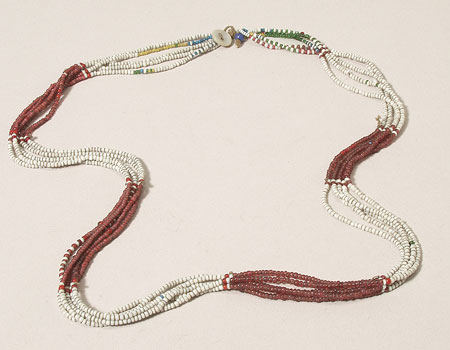Accession Number:
1925.14.11
Country:
Uganda
Region:
North of Lake Kyoga
Cultural Group:
Lango
Date Made:
By 1925
Materials:
Glass , Shell , Plant Fibre
Process:
Strung , Twisted , Tied
Dimensions:
L of string (doubled up) = 350 mm, W across 5 strands = 11 mm, diam button = 11 mm, Diam large bead = 4.5 mm, diam small beads = 1.7 mm, Th beads = 1.5 mm [RTS 25/5/2004].
Weight:
28.8 g
Other Owners:
Jack Herbert Driberg
Field Collector:
Jack Herbert Driberg
PRM Source:
Jack Herbert Driberg
Acquired:
Donated 1925
Collected Date:
By 1925
Description:
Head ornament comprising five thin plant fibre cords, each made up of multiple twisted strands, tied together at the top with a knot to form a circular fillet.
Each of these five cords has been threaded with a series of small glass ring beads with tiny perforations, with the separate strings linked by horizontal threads woven across the body at nine separate places, creating ten sections of roughly equal size.
Each section features beads predominantly in one colour, although the occasional mismatched bead has been included.
In order, these are: opaque white, translucent and occasionally opaque red (Pantone 1807C and 1797C), white, red, white, red, white, red, and white, with the final section being a mix of translucent red, opaque white, translucent green (Pantone 360C), opaque yellow (Pantone 121C) and opaque light blue beads (Pantone 299C).
Each red or white coloured section is framed at either end by a single bead of the adjacent colour.
A circular shell button has been tied to the top of the necklace, next to the knot; this has a slightly concave upper surface and irregularly flat underside, and has been pierced twice near its centre; it may be a European import.
It is opalescent, like mother-of-pearl, and white in colour.
On the other side of this knot a single, almost spherical blue glass bead (Pantone 2718C) has been attached to the cord end.
The head ornament is complete and intact, with only minor damage to the occasional bead.
It measures 350 as strung (doubled up), and is 11 mm wide across the five strands making up the body.
The button is 11 mm in diameter, and the spherical bead has a diameter and thickness of 4.5 mm.
The small ring beads are all of similar dimensions to one another, measuring approximately 1.7 mm in diameter and being 1.5 mm thick, with a total weight of 28.8 grams.
Collected by Jack Herbert Driberg in the area north of Lake Kioga, Uganda, and presented to the Pitt Rivers Museum in 1925.
In his book on the Lango, Driberg describes how such bands were worn around the forehead, just above the eyebrows, fastening at the back of the head (J.H. Driberg, 1923, The Lango , p. 62). For photographs showing similar objects being worn, see T.T.S. Hayley, The Anatomy of Lango Religion and Groups, 1947, pl. I.
This object is said to have been made up of trade beads. Powell-Cotton also collected an object using similar glass ring beads from the Lango (1934.8.95, white and red). Similar coloured ring beads are also used by the Northern Larim (1979.20.153, 1979.20.157), Lotuko (1934.8.62) and Dinka Tuich (1979.20.61).
Rachael Sparks 22/08/2005.
Collected by Jack Herbert Driberg in the area north of Lake Kioga, Uganda, and presented to the Pitt Rivers Museum in 1925.
In his book on the Lango, Driberg describes how such bands were worn around the forehead, just above the eyebrows, fastening at the back of the head (J.H. Driberg, 1923, The Lango , p. 62). For photographs showing similar objects being worn, see T.T.S. Hayley, The Anatomy of Lango Religion and Groups, 1947, pl. I.
This object is said to have been made up of trade beads. Powell-Cotton also collected an object using similar glass ring beads from the Lango (1934.8.95, white and red). Similar coloured ring beads are also used by the Northern Larim (1979.20.153, 1979.20.157), Lotuko (1934.8.62) and Dinka Tuich (1979.20.61).
Rachael Sparks 22/08/2005.
Primary Documentation:
Accession Book Entry
[VII, p.
189] - 1925 [pencil insert] 14 [end insert]
J.H.
DRIBERG
, Esq.
c/o the Postmaster, Khartoum.
Specimens collected by himself among the LANGO tribe in the UGANDA PROTECTORATE, N.
of LAKE KIOGA.
Viz: [...]
1925.206, 207
[pencil insert] 10-11 [end insert] - [1 of] 2 Chaplets of trade-bead strings, worn by women round the brow.
Additional Accession Book Entry [VII, p. 25 top, in pencil] - blue numbers not valid & not on specimens. Inserted by an assistant in error.
Card Catalogue Entry - There is no further information on the catalogue card [RTS 24/5/2004].
Pitt Rivers Museum label - Brow chaplet worn by women. LANGO tribe, UGANDA PROTECTORATE (N. of L. KIOGA). Pres. by J.H. Driberg, 1925. [El.B 'DCF 2004-2006 What's Upstairs?' 11/7/2005]
Additional Accession Book Entry [VII, p. 25 top, in pencil] - blue numbers not valid & not on specimens. Inserted by an assistant in error.
Card Catalogue Entry - There is no further information on the catalogue card [RTS 24/5/2004].
Pitt Rivers Museum label - Brow chaplet worn by women. LANGO tribe, UGANDA PROTECTORATE (N. of L. KIOGA). Pres. by J.H. Driberg, 1925. [El.B 'DCF 2004-2006 What's Upstairs?' 11/7/2005]



